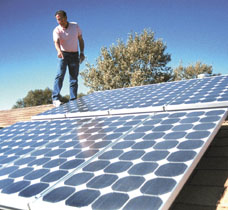| SOLAR POWER Livingston Family's Solar Array�
Tied to Montana Power Grid
By Dwight Harriman
Reprinted with permission from the Livingston
Enterprise
 Dick
Caruso has an electric meter that can run backward. And every time it
does, he saves money. Dick
Caruso has an electric meter that can run backward. And every time it
does, he saves money.
It all started with a small ad the Green Acres resident saw in a
newspaper which talked about a solar energy demonstration program,
sponsored by the National Center for Appropriate Technology in Butte and
the Montana Power Company, to set up a couple dozen solar systems around
the state. Homeowners chosen for the systems would, at the end of one
year, get to keep the $10,000 system if they kicked in $3,000 toward the
cost.
Sounded pretty intriguing to Caruso.
"I�ve always been interested in conservation things ... looking
at ways to save on oil, gas, electricity, whatever," he said.
He applied and, along with Livingston resident Marshall Engstrom, was
accepted for the program � the only Park County residents who were. His
system was installed in August, one day after Engstrom�s. Recently, on a
bright, sunny afternoon, he showed it off.
Everything starts on the roof, where three banks of four solar
panels, or photovoltaic modules, absorb the sunlight. To qualify for the
program, Caruso�s home had to have a south-facing roof pitched between
20 and 60 degrees, with 45 being the ideal.
The solar panels produce DC electricity, or direct current. The current
is fed through wires running through Caruso�s attic to a control box
mounted on his garage wall, where it is converted to AC, or alternating
current � of the type MPC provides homes.
The electricity produced by the solar panels goes first to power
Caruso's appliances. If any is left over, it is fed into the MPC power
grid, and a special electric meter mounted outside the home reflects what
is taking place: it literally starts running backward, as it was on the
day of the interview for this story.
That strange action translates into savings on Caruso�s power bill.
Meanwhile, a computer readout on the system�s control panel allows
Caruso to monitor energy data, such as how much is being produced and
consumed, and its voltage and amperage. A modem mounted on the panel
allows NCAT to monitor the system, as well. The modem will be disconnected
at the end of the yearlong program.
NCAT says that on a sunny day, a one-kilowatt system such as Caruso�s
will have an electrical output of about 1,000 watts. It also says the
system should produce about 1,500 kilowatt-hours of electricity annually,
which is equivalent to about 17 percent of the average home's annual
electrical consumption.
However, Caruso calculates the system could save him perhaps 20 percent
of his electric costs.
Seated at his kitchen table with his wife
Donna, he hauls out spreadsheets charting 18 years of power consumption
and taps out figures on � what else, a solar-powered calculator � to
confirm his savings.
"The arithmetic on this is fairly simple," says the retired
accountant matter-of-factly.
He figures he gives up about $180 a year in what his $3,000
contribution to the solar system could earn him, but in return will save
about $100 a year on his electric bill.
"And I still got the $3,000 � it�s up there on the roof,"
he says. "It�s a win-win situation."
Neighbors, of course, are curious about the array on the roof.
They ask, "What are you doing?" Caruso laughs, leaning back
in his seat. "It�s generated a lot of interest."
"I think it's going to be a real neat experiment," Donna
says.
Unfortunately, people wanting to participate in the program will be
unable to, at least for now, since it is out of funding for this round of
solar systems.
NCAT Program Specialist Ray Schott said they received 600 requests for
applications, "which totally overwhelmed us."
 However,
Schott says there is a good chance of getting funds for another handful of
installations. He also indicated there was the possibility for a similar
wind-powered program between MPC and another organization. However,
Schott says there is a good chance of getting funds for another handful of
installations. He also indicated there was the possibility for a similar
wind-powered program between MPC and another organization.
Schott said 12 Montana schools are participating in a solar program,
using solar systems twice as big as a residential one.
He said the best location in the state for catching the sun�s rays
was, not surprisingly, in eastern Montana, but added that just about
anywhere in the state would be within 80 percent of optimum solar
conditions.
Meanwhile, Caruso is watching his electric meter and bills closely.
"We�re just waiting for the bills to start coming in, so we can
see," he chuckles again.
Livingston Enterprise photos by Erik Petersen
|